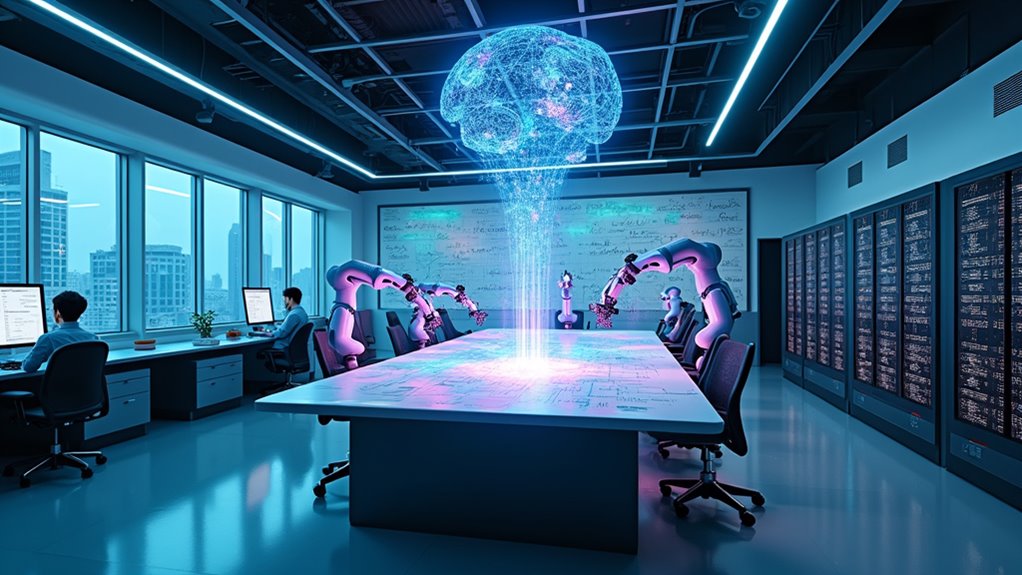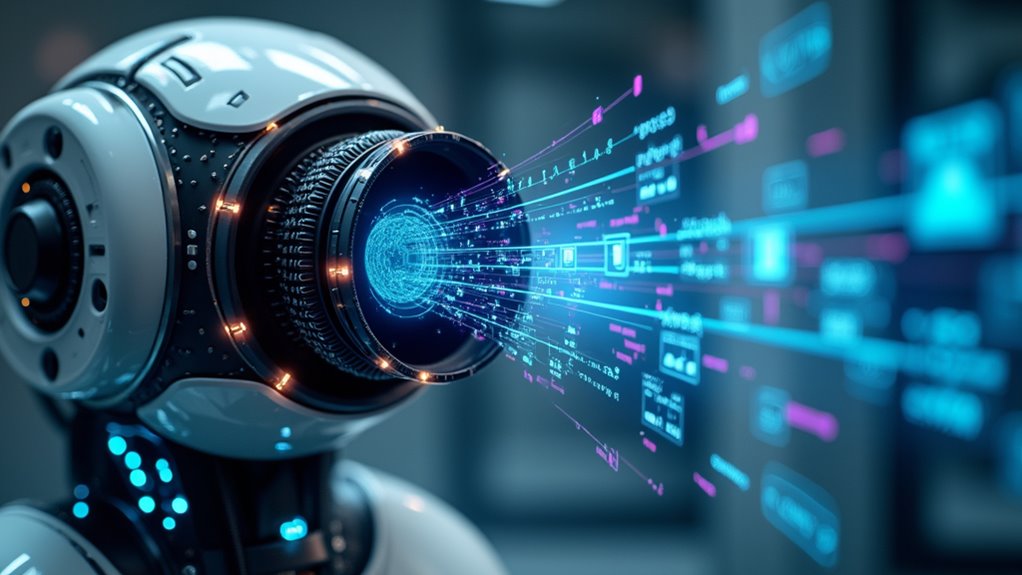AI labs are powering today’s biggest technological breakthroughs by combining diverse disciplines – from computer science to performing arts. They’re not just coding spaces; they’re intellectual melting pots where ethics meets innovation. Places like MIT’s CSAIL and The New School’s AI Lab foster collaboration that tackles healthcare diagnostics, language processing, and computer vision challenges. The secret sauce? Balancing cutting-edge research with responsible frameworks that prevent AI from reinforcing biases. Discover how these innovation hubs are shaping our technological future.

While traditional research centers focus on singular disciplines, AI labs are revolutionizing how we approach complex problems through interdisciplinary collaboration. These innovation hubs integrate artificial intelligence with diverse fields like design, social research, and even performing arts—creating unexpected solutions that single-discipline approaches simply can’t match.
Ethical frameworks form the backbone of responsible AI development, ensuring that fairness, accountability, transparency, and ethics (FATE) aren’t just buzzwords but actual guiding principles. Without these guardrails, we’d be creating powerful tools with zero moral compass. Yikes.
Designing AI without ethical guardrails is like building a rocket without navigation—powerful but dangerously directionless.
Institutions like MIT’s CSAIL have dramatically shaped AI’s global trajectory, focusing on breakthroughs in machine learning and computer vision that ripple through industries worldwide. These labs don’t exist in isolation—they thrive on partnerships between academia, industry bigwigs, and policy wonks to push technology forward. Think of them as intellectual melting pots where ideas collide and transform. The AI Lab at The New School exemplifies this approach by encouraging collaborations among faculty and students alongside industry partners and policymakers.
Healthcare represents one of AI’s most promising frontiers. GE HealthCare‘s AI Innovation Lab, for instance, is tackling diagnostic accuracy challenges head-on. Their systems analyze multi-modal data to deliver personalized care recommendations that human doctors might miss. AI-powered diagnostic tools are revolutionizing disease detection and treatment planning with transformative technologies that significantly enhance healthcare outcomes. These advancements are creating a more efficient and patient-centered healthcare system that benefits both providers and patients.
Deep learning algorithms are now predicting cancer recurrence with increasing accuracy, while administrative AI tools free up medical professionals to do what they do best—care for patients.
Research trends show no signs of slowing down. AutoML is making machine learning accessible to non-experts (finally!), while NLP and Computer Vision continue advancing at breakneck speed. Want to translate languages instantly or identify objects in milliseconds? There’s an AI for that.
Ethical considerations remain paramount as these technologies evolve. Researchers are developing strategies to minimize algorithmic bias and creating assessment frameworks to evaluate AI’s societal impact.
After all, what good is technological progress if it reinforces existing inequalities? The most successful AI labs balance innovation with responsibility, creating systems that augment human capabilities rather than diminishing human agency.
Frequently Asked Questions
How Do AI Labs Collaborate With Academic Institutions?
AI labs collaborate with academic institutions through collaborative projects that combine expertise across disciplines like healthcare and finance.
These research partnerships involve sharing resources, facilities, and tools while attracting substantial funding from both public and private sectors.
Knowledge exchanges happen through regular seminars and workshops, bringing together diverse researchers.
The collaborations typically focus on interdisciplinary approaches, with findings published in leading academic journals to maximize impact and advance the field collectively.
What Educational Qualifications Are Needed to Work at AI Labs?
Working at AI labs typically requires a bachelor’s degree in computer science, mathematics, or related fields, with most roles demanding advanced degrees.
Master’s or PhD credentials are particularly valued for research positions. Strong foundations in machine learning algorithms and data science principles are non-negotiable.
Programming proficiency (especially Python), mathematical expertise, and analytical thinking skills round out the essential qualifications.
Many professionals supplement formal education with specialized certifications to remain competitive in this rapidly evolving field.
How Is Ethical Oversight Maintained in AI Research?
Ethical oversight in AI research relies on robust ethical frameworks that protect humanity from “oops, we taught the robots to outsmart us” scenarios.
Oversight committees—comprised of diverse experts, not just tech bros—evaluate projects for bias, fairness, and potential harm.
Organizations like the AI Now Institute and IEEE Ethics Initiative establish standards that researchers must follow.
Want responsible AI? You need transparency, accountability, and regular algorithmic audits.
No shortcuts here, folks—ethics aren’t optional when machines make decisions.
What Funding Mechanisms Support Major AI Research Labs?
Major AI research labs thrive on diverse funding streams. Government grants from agencies like NSF, NIH, and DARPA provide substantial support, often rewarding breakthrough potential rather than quick profits.
Private investments come from tech giants like Google and foundations such as Chan Zuckerberg Initiative. Industry partnerships create symbiotic relationships that accelerate innovation.
This financial ecosystem—combining public funds, philanthropic contributions, and corporate backing—ensures labs can pursue both practical applications and moonshot research without solely chasing commercial outcomes.
How Do AI Labs Protect Intellectual Property While Sharing Research?
AI labs balance open science with IP protection through strategic measures.
They employ robust patent strategies for core innovations while selectively publishing research that advances the field.
Copyright protection safeguards specific implementations, while NDAs and carefully crafted licensing agreements protect commercial interests.
Most labs maintain a tiered approach: open-sourcing basic tools, publishing methodological advances, but keeping breakthrough algorithms and datasets as closely guarded trade secrets.
This hybrid model maximizes both innovation and competitive advantage.









